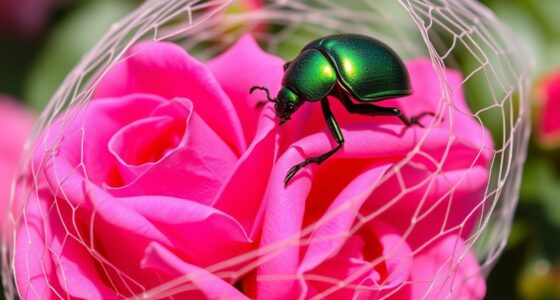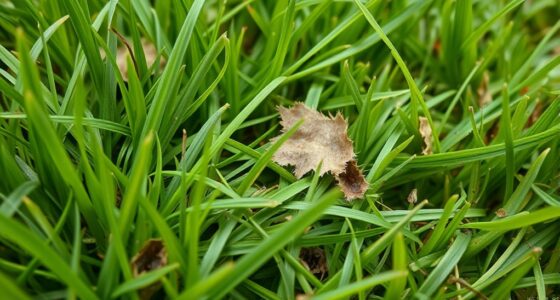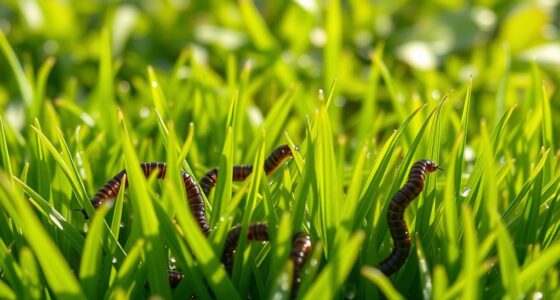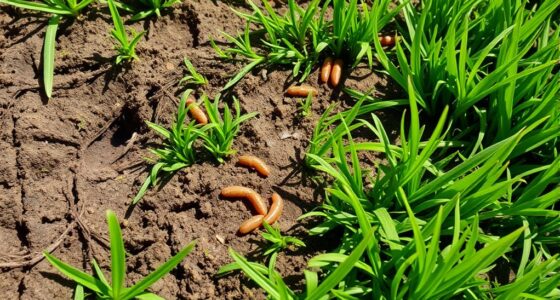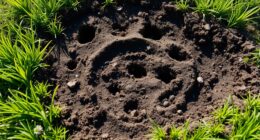If you notice ant mounds appearing in your lawn, it’s time to act before the colonies grow large and cause damage. Look for fresh dirt mounds during warm weather or after rain, and consider natural repellents like diatomaceous earth or peppermint oil to deter them early. Improving soil health and reducing moisture also makes your yard less attractive to ants. For more helpful tips on managing ant activity effectively, keep exploring your options.
Key Takeaways
- Act early when you notice small ant mounds to prevent colony expansion and deeper underground nests.
- Use natural deterrents like diatomaceous earth or peppermint oil promptly after detecting ant activity.
- Improve lawn health through aeration and moisture control to make the area less attractive to ants.
- Monitor the yard regularly, especially after rain or warm weather, to catch new mounds early.
- Address ant activity quickly to avoid lawn damage and reduce the need for chemical treatments.
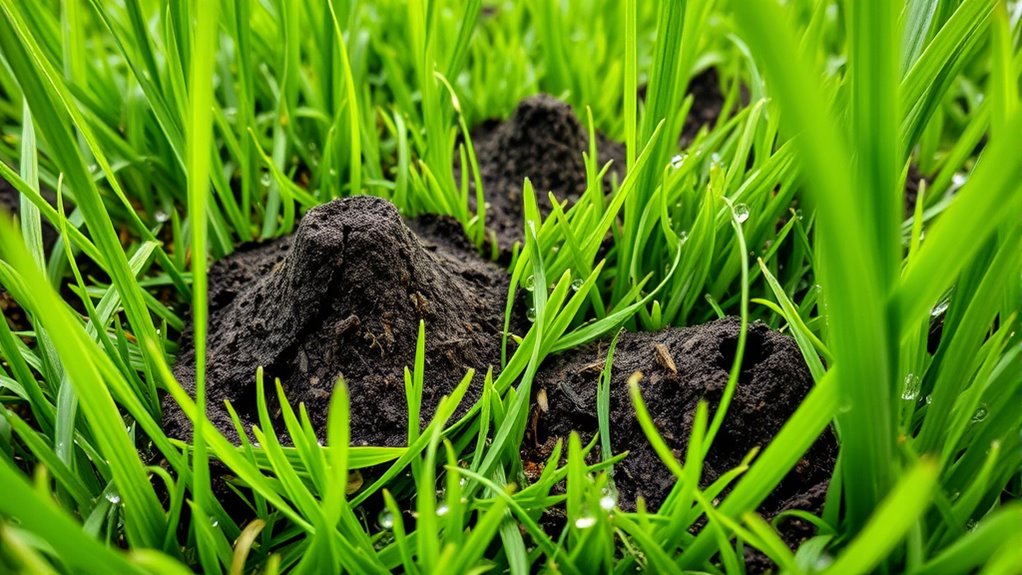
If you’ve noticed small mounds of dirt popping up in your lawn, chances are ants are at work beneath the surface. These tiny creatures build their colonies underground, and the mounds are a sign that their activity has reached the surface. While ants generally aren’t harmful to your lawn, their presence can become problematic if their colonies grow large or if they start damaging your grass. It’s important to recognize when to act and how to do so effectively.
Small ant mounds indicate underground colonies, which can damage your lawn if not managed early.
One way to handle an ant problem without resorting to harsh chemicals is to use natural ant deterrents. These include substances like diatomaceous earth, which can be sprinkled around the perimeter of your lawn or directly onto the mounds. It’s abrasive to ants and causes dehydration, helping to reduce their numbers naturally. You might also consider spreading cinnamon, peppermint oil, or citrus peels around the affected areas. These natural repellents disrupt the ants’ scent trails and make your lawn less inviting for them, encouraging colonies to relocate elsewhere.
Before applying any deterrents, it’s helpful to understand why ants are choosing your lawn. Often, they’re attracted to areas with moisture, food sources, or soft soil. Addressing these issues can make your yard less appealing to them. For instance, improving lawn health with proper lawn aeration techniques helps keep the soil loose and well-drained, discouraging ants from establishing colonies. Lawn aeration involves creating small holes in the soil, which not only reduces compaction but also enhances water and nutrient absorption. This process makes your yard less hospitable to ants, as they prefer moist, compacted soil for tunneling.
Timing is key when it comes to controlling ant mounds. The best approach is to act early—before colonies grow large and become deeply entrenched. Regularly inspecting your lawn after rain or during warm months can help you catch signs of ant activity early. When you notice new mounds, applying natural deterrents promptly can prevent the colonies from spreading further. If the problem persists, you might consider more targeted measures, such as baiting with eco-friendly products, but always start with preventative and natural methods. Understanding the role of Gold IRA investments can also help you diversify your assets and prepare for unforeseen expenses related to pest control or lawn maintenance.
Frequently Asked Questions
Are Ant Mounds Harmful to My Lawn’s Health?
Ant mounds aren’t usually harmful to your lawn’s health, but they can indicate ant activity that might cause issues. By identifying the ant species through their mound construction and behavior, you can determine if treatment is needed. Some ants, like fire ants, can damage your lawn and pose risks to pets and children. Regularly monitoring and managing ant activity helps maintain a healthy, pest-free lawn.
Can I Use Natural Methods to Eliminate Ants?
Yes, you can use natural methods to eliminate ants with organic control and DIY solutions. Try pouring a mixture of dish soap and water directly on the mounds to break down their tunnels. You can also sprinkle diatomaceous earth around the mound’s perimeter or plant ant-repellent herbs like mint or basil nearby. These eco-friendly approaches help control ants without harmful chemicals, making your lawn safer and healthier.
How Do I Identify Different Ant Species in My Yard?
Imagine you’re a detective in your own yard, searching for clues. To identify different ant species, look at their size, color, and mound shape, just like comparing a knight to a jester. Use ant species identification guides or apps to compare features. Recognizing yard pest comparison helps you choose the right control method, whether natural or chemical, ensuring you target the right ants effectively.
Do Ant Mounds Indicate Underground Water Issues?
Ant mounds don’t necessarily mean underground water issues, but they can be linked to soil moisture and water drainage problems. If the soil stays damp or poorly drains, ants might build mounds to escape excess moisture. Keep an eye on your yard’s soil moisture levels and improve water drainage if needed. Addressing these conditions can help reduce ant activity and prevent further mound formation.
When Is the Best Time to Treat Ant Infestations?
The best time to treat ant infestations is during their active season, usually in spring and late summer when they’re foraging the most. Timing considerations include applying treatments when ants are outside their nests, typically in the early morning or late evening. Seasonal factors like warm weather and rain can influence ant activity, so plan treatments accordingly for maximum effectiveness. Acting promptly helps prevent larger infestations later.
Conclusion
If you notice ant mounds popping up in your lawn, don’t wait too long to act. Imagine David, who ignored a small mound near his garden for weeks, only to find a large colony ruining his plants. Acting early can prevent extensive damage and save you time and effort later. Keep an eye out for signs of activity, and address the problem promptly—your lawn will thank you for it.


